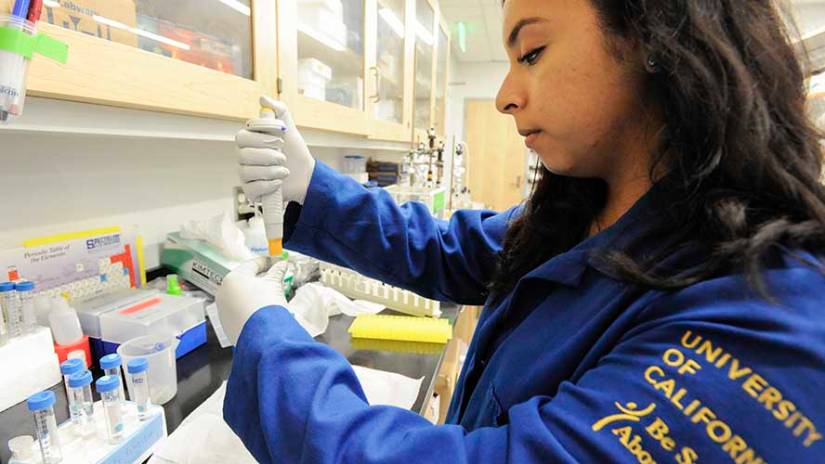
Santa Monica College (SMC) alum Jonah Okike spent the summer at a University of California, Los Angeles (UCLA) research lab building a robotic arm that would be capable of performing an MRI-guided biopsy. SMC student Heather Haro spent hers looking for antibiotic-resistant genes in the Los Angeles human microbiome.
Okike, who recently transferred from SMC to Cornell University as a mechanical engineering major and Heather Haro, an environmental science major, were among 18 SMC students selected by UCLA for a ten-week paid research internship. Additionally, 50 SMC Science, Technology, Engineering and Mathematics (STEM) majors also participated in a weeklong residency at UCLA – getting a preview of university life – all as part of the SMC-UCLA STEM “Science & Research Initiative (SRI)”.
“Our partnership with UCLA has prepared our students for an intensive research environment and given them the knowledge they need for transfer,” says Melanie Bocanegra, SMC Associate Dean for STEM and Student Equity. “Our professors and counselors work together to develop curriculum and workshops that prepare our STEM students for this opportunity and our students realize that they are never alone in their ‘STEM path.’”
SMC established its successful STEM-SRI program in partnership with UCLA funded by a five-year $5.8 million grant from the U.S. Department of Education, awarded in 2011. STEM students at SMC avail of specialized courses, free counseling and tutoring, and research opportunities at UCLA through its Center for Community College Partnerships and the Undergraduate Research Center.
SMC biochemistry major Maria Cabrera – who also interned at UCLA – says that the close support and rapport that SMC’s STEM-SRI program provides has been crucial in helping her stay focused. Cabrera takes two Metro train transfers and a bus to get to SMC from her home in the San Fernando Valley.
“In high school, I had no idea what I wanted to do,” says Cabrera. She “randomly picked some majors” after graduating, but after being rejected from the universities she applied to – including UCLA! – she decided to come to SMC. After getting an email from the STEM program inviting her to apply, she stumbled on a newfound – and unexpected – passion.
Cabrera’s research this summer at UCLA’s Department of Human Genetics comprised of exploring the effects gonadal hormones might have on pancreatic cells, and how these hormones might contribute to differences in how males and females get diabetes induced by Statin, the cholesterol-lowering drug.
Like Cabrera, neither Okike nor Haro had ever considered STEM prior to arriving at SMC. Okike struggled academically in high school and enrolled in business and computer science courses at SMC for a year until he applied to the STEM-SRI program, on a counselor’s recommendation. Suddenly, his childhood dream – of inventing things – came full circle.
“I am really, really grateful to my professors at SMC for pushing me in this direction,” said Okike, now at Cornell and who earlier this year also won the Jack Kent Cooke Scholarship, the nation’s largest private scholarship for transfer students.
“The STEM program at SMC offered so much for me – their doors were open any time. I’ve made it to this point because of them,” added Okike.
As for Heather Haro – who also serves as Director of Sustainability for SMC’s Associated Students – the College is a place of “first experiences.” Before going on a camping trip with her geography field studies class, the Valley native had never slept in the outdoors. Then, as a student worker at SMC’s Center for Environmental and Urban Studies, Haro got her hands dirty: by working at the College’s organic learning garden, another “first.”
“Everything I’ve come to love about sustainability happened at SMC,” says Haro. Her father, who suffers from diabetes, is on dialysis after his kidneys began malfunctioning, and Haro is bent on helping him – by solving root problems in the environment.
“I want to identify – and help solve – problems in the environment,” says Haro. “Even a disease like diabetes can be traced back to access of food, and to find solutions through science and policy would go beyond a ‘Band-Aid solution’.”
Haro hopes to transfer to the Soil Science undergraduate program at the University of California, Davis, or to UCLA’s Environmental Engineering program. She aspires to work for the Environmental Protection Agency (EPA) to “push scientific research forward” and also “be an advocate for my community and the environment.”
“The field of science touches my heart the most,” says Haro. “It’s just one small piece of the puzzle but I like the idea that what I’m researching and learning can actually make a difference.”
SMC’s STEM program recently received another boost in the form of a MUREP Community College Curriculum Improvement (MC3I) grant from NASA, one of four U.S. community college recipients. It will provide up to $250,000 per year for a maximum of three years to provide training for SMC professors teaching STEM, and to expand STEM course offerings.
For more information about SMC’s STEM-SRI program, visit www.smc.edu/STEM or call (310) 434-3993. SMC has also expanded academic support services for STEM students – including chemistry and math boot camps – as part of an overall move to help reduce the disparity that exists in academic achievement between historically underrepresented students and their peers.
Of the 176 students enrolled in the STEM-SRI program this year – 59 percent come from traditionally underrepresented backgrounds and 52 percent are from low-income households.



